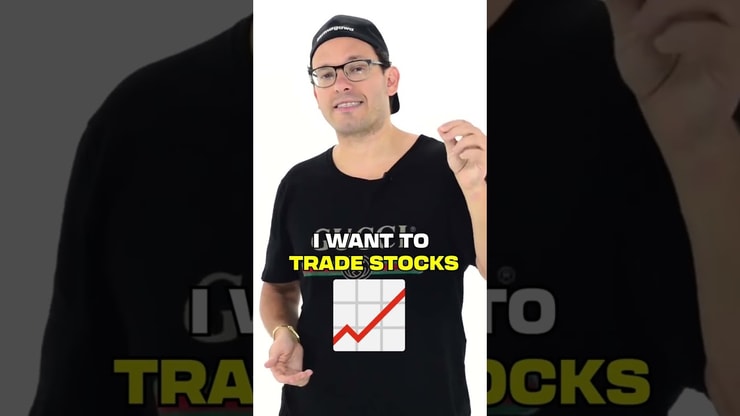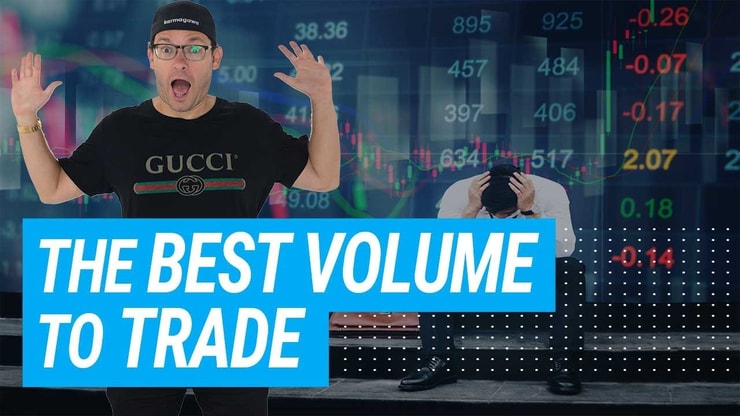Traders use volume price analysis to determine good trade setups. It involves following the change in share volume in tandem with the change in price.
Volume is a HUGE indicator that I use every single day.
All my millionaire students use it too.
One of the first things I showed them was how to analyze volume alongside price.
A lot of new traders only look at the price chart … that’s only half of the story.
It tells us what the share price is, but it doesn’t tell us how many shares are traded.
‘How many shares’ is an important measurement.
It shows us …
- The stock’s popularity
- Periods of support and resistance
- Confirmation of breakouts
- Potential future weakness
Once my students see the process and experience the market, this analysis becomes second nature.
Like most jargon in the stock market, volume price analysis isn’t as scary as it seems.
If you want to understand market mechanics, you’re in the right place.
I have more than enough experience teaching traders over the last decade. I have over 30 millionaire students with more on the way.
So without further ado, let’s get to the nitty gritty …
Table of Contents
- 1 What Is Volume Price Analysis?
- 2 Key Elements in Volume Price Analysis
- 3 Applying Volume Price Analysis in Trading
- 4 Interpreting Volume Price Analysis
- 5 Volume Price Analysis in Different Market Conditions
- 6 Key Takeaways
- 7 Frequently Asked Questions
- 7.1 Why Is Price Rising and Volume Rising in the Rally?
- 7.2 How Does Volume Price Analysis Reflect Price?
- 7.3 How Does Volume Display Emotions in Trading?
- 7.4 How Does Volume Price Analysis Relate to Value and Investing, and Can You Provide an Example?
- 7.5 Where Can I Find More Detailed Pages or Guides on Using Volume Price Analysis on Your Site?
- 7.6 What Services or Account Features Do You Offer To Assist Readers in Understanding and Applying Volume Price Analysis?
What Is Volume Price Analysis?

Volume price analysis is a powerful tool that brings together volume and price to determine the market direction. It goes beyond mere numbers and gives traders insights into the market structure, trend, and potential reversals.
By looking at how volume and price changes correlate, a trader can grasp the underlying demand and supply in the market.
In essence, VPA gives insight into the psychology of buyers and sellers, which can be pivotal in predicting future price movements. It’s not about memorizing charts; it’s about developing an understanding of the market’s logic and its people.
In many ways, the stock market is an alien world. It has its own language and laws.
So many traders lose because they fail to recognize how little they understand. And there wasn’t a clear path to trading self-sufficiency … until I started the Challenge.
All of my millionaire students came from the Challenge. It’s the same path that I beat through the jungle and led me to over $7.4 million in trading profits.
There are always risks when it comes to trading. But those that join my Challenge don’t have to wander around in the dark.
>> Here’s the path my millionaire students took. <<
You’re already headed in the right direction. Volume price analysis is an essential tool.
And understanding relative volume is a crucial aspect of volume price analysis. The relative volume compares the current trading volume to the average volume for the same time of day.
This comparison helps traders identify significant volume spikes or drops, which can signal potential market moves. By incorporating relative volume into your analysis, you can gain deeper insights into the market’s behavior and make more informed trading decisions.
If you’re interested in learning more about this essential concept, you can explore my detailed guide on how to use relative volume in trading.
Key Elements in Volume Price Analysis
Volume price analysis is more than just watching numbers; it’s about understanding the key elements that drive markets.
Watch the quick video below for more details …
Authors like Anna Coulling and Jesse Livermore wrote extensively about the importance of understanding these elements.
The primary focus here is on volume analysis, and how it’s used in conjunction with price to determine market trends. Various books and articles provide content, details, reviews, and lists that empower community members.
By understanding the kind of business, company, product cost, and consumer behavior, traders can leverage volume analysis to increase revenue and profit.
Recognizing this balance in the market is a valuable commodity that can change the way you approach trading, investment, and even life itself.
Day trading indicators are vital tools that provide insights into market trends and potential reversals.
From moving averages to bollinger bands, these indicators help traders make sense of market movements and plan their strategies accordingly. Understanding how to use these indicators effectively can enhance your trading experience and increase your chances of success.
If you’re looking to deepen your knowledge of day trading indicators and how to apply them in your trading, don’t hesitate to explore my comprehensive guide on day trading indicators.
What to Know About Volume Indicators

Volume indicators are essential tools in volume price analysis. They provide valuable insights into the strength or weakness of a trend.
By observing the amount of trading volume behind price movements, traders can gauge the power and conviction of buyers and sellers. In fact, it speaks volumes …
Understanding volume indicators, in conjunction with chart patterns, allows traders to make more informed decisions. Whether you’re using bar charts or focusing on moving averages, the information these indicators provide will enhance your trading strategy.
They add a depth of understanding that mere price analysis cannot achieve on its own.
And choosing the correct chart software is paramount.
The stocks we trade are highly volatile. They offer huge profit opportunities, but the moves are quick. That means we need a streamlined process with the fastest data to stay competitive.
Free chart software displays data 10-20 minutes late. That’s too slow. I’d be a sitting duck.
That’s why I helped design StocksToTrade.
It has up-to-date data and a user-friendly platform that includes any trading gadget I could ever need.
And there’s no need to break the bank …
Try this 14-day StocksToTrade trial for just $7.
You’ll never see the market the same again.
Now let’s get to the first indicator in our series …
What Is the Negative Volume Index?
The Negative Volume Index (NVI) is one of the unique indicators in volume price analysis. It highlights how the price moves on days when the volume decreases compared to the previous day.
The underlying idea is that “smart money” often trades when the market is less active.
NVI offers insights into potential trend reversals and the hidden intentions of experienced investors and traders.
By understanding this aspect of volume price analysis, traders can grasp what’s happening beneath the surface. Think of it as reading the hidden intentions of the market, something that can turn fortunes in trading.
More Breaking News
- Will Broadcom (AVGO) Soar Following Stellar Q4 Results?
- MicroStrategy’s Meteoric Rise: Is it Time to Get Excited or Proceed with Caution?
- Jet.AI: Key Compliance Milestones and New Ventures. What’s Behind the Buzz?
Understanding On-Balance Volume
On-Balance Volume (OBV) is a powerful tool in volume price analysis. It accumulates the total volume, adding the day’s volume if the price closes higher and subtracting if it closes lower.
This gives a cumulative total, reflecting the strength of the trend.
Traders use OBV to confirm trends and potential reversals. By studying the OBV in conjunction with price action and other technical analysis tools, one can make more informed and effective trading decisions.
In the world of stocks and commodities, this is a valuable asset in any trader’s toolkit.
How Price Volume Accumulation/Distribution (A/D) Works

The Accumulation/Distribution (A/D) line is a volume-based indicator used to confirm price trends and detect any divergence that might signal a potential reversal.
Here are the main principles, it looks at the close price relative to the range for a given period and multiplies this by the volume for that period.
The A/D line can reveal underlying strengths or weaknesses that might not be evident in the price itself.
By analyzing this in conjunction with other indicators like the moving average convergence/divergence (MACD), traders gain a powerful perspective on market direction and sentiment. It’s more than just numbers; it’s about understanding the market’s heartbeat.
Applying Volume Price Analysis in Trading
The struggle is real, but applying volume price analysis in trading can provide a significant advantage.
From the early days of Richard Ney to modern analysts, understanding volume analysis has been a critical aspect of successful trading. Options are vast, and the application varies from thousands of stocks to commodities and other investment forms.
This section explores how to translate the content of books and articles into real-world strategies.
But if you pay more attention during videos, below there’s a longer version of my earlier video with more detail …
Examining factors like company industry, product cost, consumer behavior, revenue streams, and profit margins also provides essential insights.
Whether you’re a novice or an experienced trader, understanding these elements can make a tangible difference in your trading decisions.
The Volume Weighted Average Price (VWAP) is a powerful tool used by traders to gauge the market’s direction.
It calculates the average price of a security, weighted by volume, providing a more accurate reflection of the market’s sentiment. Utilizing VWAP in your trading strategies can help you identify entry and exit points, manage risk, and align your trades with the market’s momentum.
If you’re keen to incorporate VWAP into your trading toolkit, you can find more information in my in-depth guide on how to use the VWAP indicator.
Volume Price Analysis: How You Can Use It in Trading Strategies
Using Volume Price Analysis (VPA) in your trading strategies is like having an inside view of market dynamics.
It’s not just about recognizing trends; it’s about understanding the balance between buyers and sellers, the underlying demand, and the supply at various price levels.
VPA can be applied across various markets, whether stocks, commodities, or indices. By integrating volume with price action, traders can identify potential reversal points, support and resistance levels, and even the strength of the existing trend.
It’s a way of decoding the market’s language, and it’s invaluable for both day traders and long-term investors.
Two Main Market Phases: Accumulation & Distribution

In volume price analysis, two main phases stand out: accumulation and distribution. They play off of each other.
Accumulation is when the “smart money” is buying, often unnoticed. Distribution, on the other hand, happens when these informed traders are selling, once again often below the radar.
Understanding these two phases is crucial in identifying the likely direction of the market price. By analyzing volume and price in these contexts, a trader can align themselves with the big players in the market.
It’s like having a guide on your trading journey, one that has seen it all before.
Best Way to Calculate the Positive Volume Index
The Positive Volume Index (PVI) focuses on days when the volume increases compared to the previous day.
Contrary to NVI, PVI assumes that on days with increased volume, the “uninformed” traders are active.
Calculating PVI is a matter of understanding these dynamics and interpreting them in the context of the overall market structure.
By doing so, a trader can identify potential market moves and trends that might be overlooked otherwise. PVI isn’t just a number; it’s a lens through which to view the market, one that can be vital in your trading decisions.
Interpreting Volume Price Analysis

Interpretation is everything. Charles Dow, one of the fathers of technical analysis, knew that understanding the reasons behind price and volume movements was crucial to success.
In the world of trading, interpreting volume price analysis means understanding the market’s head and tail, the duration of trends, and the imbalance between supply and demand.
Many traders often refer to books, articles, and community members for insights and memories of successful strategies.
This section delves into the language of the market, the words that convey meaning, the bottom line of each trade, and the complexities of tax structures, among other areas. It’s not just about numbers; it’s about the stories they tell and the trade opportunities they reveal.
How Do You Read Volume Price Analysis?
Reading volume price analysis is an art form in itself. It’s not just about looking at numbers and charts; it’s about interpreting what those figures mean in the context of the market.
Whether it’s understanding the volume profile of a particular stock or recognizing the divergence in a trend, it all comes down to interpretation.
Think of it as having a conversation with the market.
By analyzing the volume and price, you can understand what the market is telling you. From the accumulation phase to the distribution, recognizing these patterns and what they mean can guide your trading decisions.
It’s a dialogue, one that every successful trader learns to understand.
Volume Price Analysis in Different Market Conditions

The market is a complex entity, affected by numerous variables like sales, business structure, company health, industry trends, product development, cost management, consumer interests, and more.
It’s a constantly changing landscape, and volume price analysis offers a way to navigate through it.
Jesse Livermore once noted that understanding market conditions required more than just logic; it required an insight into the heart of the market. This section brings together the wisdom from books, the experience of community members, and the facts gathered from in-depth market reviews.
From the excitement of a rally to the caution of a downturn, it covers the spectrum of emotions and realities that traders face every day. Understanding these dynamics is essential to not just surviving but thriving in the volatile world of trading.
What Happens During a Volume Price Rally?
During a volume price rally, traders notice an increase in volume, coupled with a sharp rise in price.
This phenomenon is often observed in stock markets where demand is high.
Both buyers and sellers become active, leading to more trades and a bustling market environment. In the world of day trading, it’s essential to understand this growth in volume as it signals a potential change in market direction.
Investors and traders take note of these changes to align their trading strategies with market trends, making informed decisions based on the volume indicators.
What Happens After a Volume Price Rally?
The aftermath of a volume price rally may lead to a variety of market conditions. Analysts and traders closely monitor volume and price changes to gauge what may come next.
A decrease in volume after a rally may signal a potential decrease in price or a period of distribution.
On the other hand, if the volume continues to grow, the rally might continue. This stage is where understanding market structure and trends plays a crucial role for everyday traders, investors, and even brokers.
Monitoring these movements provides insight into market prices and potential future actions, guiding trading decisions.
How To Identify a Short Covering or Long Buying Rally
In trading, identifying a short covering or long buying rally is essential to determine market direction.
A short-covering rally happens when a significant number of short-sellers cover their positions, driving prices higher.
In contrast, a long buying rally occurs when buyers actively purchase assets, causing an increase in price. Traders, employing technical analysis and watching volume indicators, can pinpoint these occurrences.
The utilization of charts and moving averages helps in spotting the difference between these rallies. Recognizing these types of rallies supports traders in their decisions and strategy adjustments according to market behavior.
Key Takeaways

- Volume Price Analysis: It’s a powerful tool in trading that combines both volume and price analysis to understand market trends and direction. By understanding the relationship between volume and price, traders can make informed decisions.
- Key Elements: It involves understanding various indicators like on-balance volume, negative volume index, and more. These tools are essential for market analysis and strategy planning.
- Application and Interpretation: Applying volume price analysis helps in recognizing different market phases and conditions like accumulation, distribution, and divergence. Understanding these concepts strengthens trading strategies and results.
- Market Conditions: Analyzing the volume and price during and after a rally is vital to comprehend market changes and adapt trading approaches accordingly.
It isn’t a silver bullet for your trading plan — but volume price analysis is one of many topics you should learn as part of your trading education!
Trading isn’t rocket science. It’s a skill you build and work on like any other. Trading has changed my life, and I think this way of life should be open to more people…
I’ve built my Trading Challenge to pass on the things I had to learn for myself. It’s the kind of community that I wish I had when I was starting out.
We don’t accept everyone. If you’re up for the challenge — I want to hear from you.
Apply to the Trading Challenge here.
Trading is a battlefield. The more knowledge you have, the better prepared you’ll be.
Do you use volume price analysis in your trading strategy? Let me know in the comments — I love hearing from my readers!
Frequently Asked Questions
Why Is Price Rising and Volume Rising in the Rally?
Price rises with volume in a rally due to increased demand and active trading.
Buyers and sellers interact more frequently, leading to price movement. This increase in trading activity reflects the bullish sentiment in the market, often associated with positive economic or industry news.
For traders, these are signs of potential opportunities.
How Does Volume Price Analysis Reflect Price?
Volume Price Analysis reflects price by showing the correlation between the volume of trades and the price action.
A rise in volume often leads to price changes, either up or down.
By analyzing these two aspects in conjunction, traders can gain insight into the market direction, strength, and potential future movements.
How Does Volume Display Emotions in Trading?
Volume displays emotions in trading by indicating the intensity of buying or selling in the market.
High volume can signify strong interest, excitement, or even panic. Analyzing volume alongside price changes gives traders insights into the market’s emotional state, allowing them to make more informed decisions.
How Does Volume Price Analysis Relate to Value and Investing, and Can You Provide an Example?
Volume Price Analysis (VPA) evaluates the relationship between volume and price to predict market trends.
It is crucial in assessing the value of a particular asset and is commonly used in investing strategies.
For example, if high volume accompanies a price increase, it usually indicates a bullish trend.
Where Can I Find More Detailed Pages or Guides on Using Volume Price Analysis on Your Site?
You can explore various pages on our site dedicated to volume price analysis.
They include tutorials, examples, and tools for implementing these strategies in your trading. Check the “Guides” section or use the site’s search feature to find specific content.
What Services or Account Features Do You Offer To Assist Readers in Understanding and Applying Volume Price Analysis?
Our platform offers various services to assist readers, including personalized account dashboards, interactive charts, and analytical tools.
We also provide tutorials and examples in English, catering to a broader audience interested in mastering volume price analysis.




Leave a reply